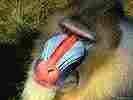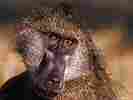
baboons
Wild Animals
alligators
baboons
bears
chimpanzees
crocodiles
deer
dolphins
elephants
foxes
giraffes
gorillas
leopards
lions
seals
sharks
snakes
tigers
whales
wolves
zebras
Pets
dogs
cats
fish
birds
|
This site provides you with the information about baboons, baboon information online, baboon pictures online, baboon photos, baboon pics for kids, images of baboons, baboon description, free baboon info, and more.
If you think that this site is helpful, please recommend your friends to visit our site.
baboons
Baboon, common name applied to certain large African monkeys and sometimes to the closely related gelada. Baboons generally are adapted to life on the ground and avoid forests; they range in large herds, called troops, over rocky, open lands and wooded areas of Africa and Arabia.
Powerful and aggressive animals about the size of a large dog, baboons have strong, elongated jaws, large cheek pouches in which they store food, and eyes close together. They have overhanging brows and strong limbs. Baboons can distinguish colors and have a keen sense of smell. They have large, often brightly colored, hairless areas on their buttocks, and thick, sturdy legs. The tail is generally short and is carried high in an arch.
Baboons eat various worms, eggs, insects, reptiles, crabs, mollusks, small mammals, fruits, and young shoots. Their troops are often composed of 30 to more than 100 members. Baboons have several different calls, many of which have specific meanings. After a gestation period of about six months, a female usually bears a single offspring, which clings to its mother's underside. Rarely a female will have twins.
The largest of the baboons is the chacma of southern Africa. Known also as the pig-tailed baboon, it is grayish-brown with a green tint along the back. The adult male may weigh up to 41 kg (90 lb) and is a formidable fighter against the troop's enemies.
The olive baboon is found in the sub-Saharan savannah region extending from Mali to Ethiopia and northern Tanzania and also in several mountainous regions of the Sahara desert. It has a darker brown coat than that of the chacma.
The yellow baboon is native to western, central, and eastern Africa, south to Mashonaland in Zimbabwe. The several subspecies of these baboons all have light yellow coats and blackish faces.
Another well-known species is the North African hamadryas baboon of North Africa and the southwestern Arabian Peninsula. It is known as the sacred baboon because it was deified by the ancient Egyptians. It has a pink face and a long snout, and males have a long mane covering the neck and shoulders.
The mandrill, a large baboon of western Africa, has an enormous head, crested and bearded, and almost no forehead. Another western African species is the drill, somewhat smaller than the mandrill, but similar in its lack of aggressive behavior. The gelada, the only true primate grazer, sleeps in the cliffs of gorges in central Ethiopia.
Scientific classification: Baboons belong to the family Cercopithecidae. The chacma is classified as Papio ursinus, the olive baboon as Papio anubis, the yellow baboon as Papio cynocephalus, the hamadryas baboon as Papio hamadryas, the mandrill as Papio sphinx, the drill as Papio leucophaeus, and the gelada as Theropithecus gelada.




|